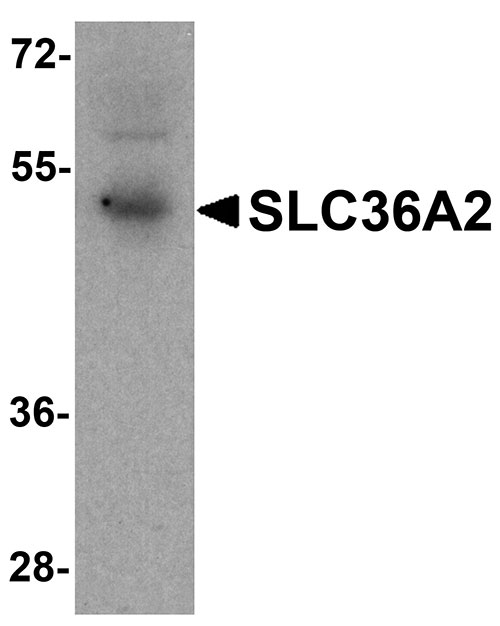SLC36A2 Antibody
- SPECIFICATION
- CITATIONS
- PROTOCOLS
- BACKGROUND

Application
| WB, E |
|---|---|
| Primary Accession | Q495M3 |
| Other Accession | NP_861441, 222418631 |
| Reactivity | Human |
| Host | Rabbit |
| Clonality | Polyclonal |
| Isotype | IgG |
| Calculated MW | Predicted: 53 kDa Observed: 52 kDa |
| Application Notes | SLC36A2 antibody can be used for detection of SLC36A2 by Western blot at 1 - 2 µg/ml. |
| Gene ID | 153201 |
|---|---|
| Target/Specificity | SLC36A2; SLC36A2 antibody is human specific. SLC36A2 is predicted to not cross-react with other members of the SLC36 protein family. |
| Reconstitution & Storage | SLC36A2 antibody can be stored at 4℃ for three months and -20℃, stable for up to one year. |
| Precautions | SLC36A2 Antibody is for research use only and not for use in diagnostic or therapeutic procedures. |
| Name | SLC36A2 (HGNC:18762) |
|---|---|
| Function | Electrogenic proton/amino acid symporter with a high selectivity for the small side chains amino acids glycine, alanine and proline, where both L- and D-enantiomers are transported. Extension of the backbone length, as in beta-alanine and 4-aminobutanoate or methylation of the amino group, as in sarcosine and N,N- dimethylglycine, are also tolerated but decrease transport efficiency. A free carboxyl group is preferred. |
| Cellular Location | Cell membrane; Multi-pass membrane protein. Endoplasmic reticulum membrane {ECO:0000250|UniProtKB:Q8BHK3}. Recycling endosome membrane {ECO:0000250|UniProtKB:Q8BHK3} |
| Tissue Location | Abundantly expressed in kidney and muscle. Expressed in the S1 segment of the proximal tubule close to the glomerulus. |

Thousands of laboratories across the world have published research that depended on the performance of antibodies from Abcepta to advance their research. Check out links to articles that cite our products in major peer-reviewed journals, organized by research category.
info@abcepta.com, and receive a free "I Love Antibodies" mug.
Provided below are standard protocols that you may find useful for product applications.
Background
SLC36A2 is a pH-dependent proton-coupled amino acid transporter that belongs to the amino acid auxin permease 1 protein family. The encoded protein primarily transports small amino acids such as glycine, alanine and proline (1,2). Both SLC36A2 and its paralog SLC36A1 are expressed in neurons, but SLC36A2 localizes to the endoplasmic reticulum and recycling endosome, while SLC36A1 is expressed in the lysosome (2). SLC36A2 is thought to contribute to neuronal transport and sequestration of amino acids such as glycine, alanine, and proline (2). Mutations in this gene are associated with iminoglycinuria and hyperglycinuria (3).
References
Boll M, Foltz M, Rubio-Aliaga I, et al. Functional characterization of two novel mammalian electrogenic proton-dependent amino acid cotransporters. J. Biol. Chem. 2002; 277:22966-73.
Rubio-Aliaga I, Boll M, Vogt Weisenhorn DM, et al. The proton/amino acid cotransporter PAT2 is expressed in neurons with a different subcellular localization than its paralog PAT1. J. Biol. Chem. 2004; 279:2754-60.
Broer S, Bailey CG, Kowalczuk S, et al. Iminoglycinuria and hyperglycinuria are discrete human phenotypes resulting from complex mutations in proline and glycine transporters. J. Clin. Invest. 2008; 118:3881-92.
If you have used an Abcepta product and would like to share how it has performed, please click on the "Submit Review" button and provide the requested information. Our staff will examine and post your review and contact you if needed.
If you have any additional inquiries please email technical services at tech@abcepta.com.













 Foundational characteristics of cancer include proliferation, angiogenesis, migration, evasion of apoptosis, and cellular immortality. Find key markers for these cellular processes and antibodies to detect them.
Foundational characteristics of cancer include proliferation, angiogenesis, migration, evasion of apoptosis, and cellular immortality. Find key markers for these cellular processes and antibodies to detect them. The SUMOplot™ Analysis Program predicts and scores sumoylation sites in your protein. SUMOylation is a post-translational modification involved in various cellular processes, such as nuclear-cytosolic transport, transcriptional regulation, apoptosis, protein stability, response to stress, and progression through the cell cycle.
The SUMOplot™ Analysis Program predicts and scores sumoylation sites in your protein. SUMOylation is a post-translational modification involved in various cellular processes, such as nuclear-cytosolic transport, transcriptional regulation, apoptosis, protein stability, response to stress, and progression through the cell cycle. The Autophagy Receptor Motif Plotter predicts and scores autophagy receptor binding sites in your protein. Identifying proteins connected to this pathway is critical to understanding the role of autophagy in physiological as well as pathological processes such as development, differentiation, neurodegenerative diseases, stress, infection, and cancer.
The Autophagy Receptor Motif Plotter predicts and scores autophagy receptor binding sites in your protein. Identifying proteins connected to this pathway is critical to understanding the role of autophagy in physiological as well as pathological processes such as development, differentiation, neurodegenerative diseases, stress, infection, and cancer.


